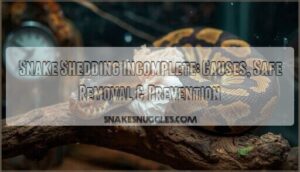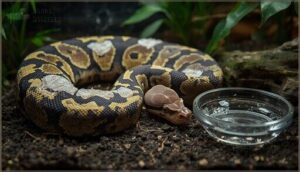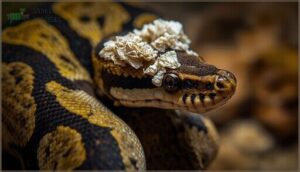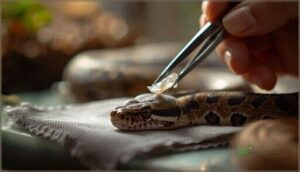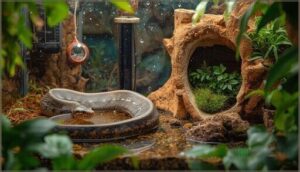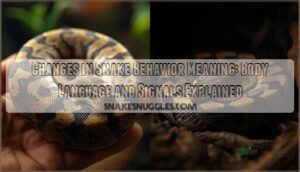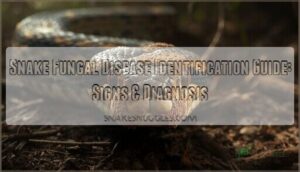This site is supported by our readers. We may earn a commission, at no cost to you, if you purchase through links.
Your ball python’s shed comes off in ragged patches instead of one elegant sleeve, and now you’re staring at retained skin clinging to eye caps and tail tip. Incomplete shedding—dysecdysis—isn’t just cosmetic. Retained fragments constrict circulation, trap bacteria against vulnerable tissue, and can lead to necrosis if ignored.
The culprit is usually environmental: humidity too low, temperatures fluctuating, or rough surfaces missing from the enclosure. But nutritional gaps, underlying infections, and chronic stress also derail the process.
Identifying what went wrong protects your snake from infection, vision loss, and permanent scarring, while safe removal techniques and targeted prevention keep future sheds smooth and complete.
Table Of Contents
Key Takeaways
- Incomplete shedding—dysecdysis—happens when environmental factors like humidity below 55%, temperature fluctuations, or missing rough surfaces fail to support the physiological fluid shifts that separate old skin from new, leaving retained fragments that can constrict circulation and trigger infections.
- Retained skin on eye caps, tail tips, and body patches creates urgent risks including vision impairment in 11% of chronic cases, tail necrosis requiring amputation if untreated beyond four weeks, and bacterial colonization beneath trapped moisture that progresses to systemic infection.
- Safe removal combines rehydration through 70-75% humidity, lukewarm soaking at 26-30°C for 15-20 minutes, and gentle manual assistance with silicone-tipped tools—but never force attached skin, since aggressive pulling increases injury risk by 30% and can cause permanent scale damage.
- Prevention demands precision in three areas: maintaining species-specific humidity gradients with digital monitoring, feeding whole-prey diets to prevent the vitamin A and protein deficiencies that compromise skin integrity by 30%, and installing textured surfaces like cork bark across 10-20% of floor space to create friction zones that mechanically assist ecdysis.
Why Do Snakes Experience Stuck Shed?
Shedding isn’t just a cosmetic event—it’s a complex physiological process where your snake’s body orchestrates fluid shifts beneath the old skin to separate it cleanly from the new layer beneath. When everything works as it should, the entire skin slips off in one translucent piece, leaving your snake with fresh, vibrant scales.
But when humidity drops, nutrition falters, or illness creeps in, this delicate process breaks down, leaving patches of retained skin that can threaten your snake’s health if you don’t intervene.
When humidity, nutrition, or health falters, the shedding process breaks down and leaves dangerous patches of retained skin
The Shedding Process in Snakes
Your snake’s shedding process—known clinically as ecdysis—involves the complete detachment and renewal of the superficial epidermal generation, including all keratinized layers down to the newly formed tissue beneath. Young snakes typically shed every 2–4 weeks to accommodate rapid growth, while mature adults may shed only a few times annually.
This adaptive molting cycle depends heavily on temperature, humidity, nutritional intake, and reproductive status. Understanding these shedding cycles helps you distinguish normal skin regeneration from problematic dysecdysis or incomplete shedding that requires intervention. Factors like snake shedding frequency play a key role in assessing the health and well-being of snakes.
Normal Vs. Problematic Shedding
Recognizing the difference between routine skin renewal and dysecdysis lets you catch problems early. Healthy snakes complete shedding in one intact piece approximately 4–8 times yearly, though juveniles may shed every few weeks as they grow.
When retained skin clings to eye caps or tail tips—a complication affecting up to one-third of captive snakes at least once—you’re witnessing incomplete shedding. Over 70% of these cases trace back to humidity control failures or inadequate husbandry, making environmental factors your first diagnostic checkpoint.
Understanding the process of snake skin shedding is vital for identifying potential issues.
Causes of Incomplete or Stuck Shed
Incomplete shedding, or dysecdysis, doesn’t happen by accident—it’s your snake’s way of signaling that something in its environment or health isn’t right.
Understanding the root causes puts you in control and helps you prevent the problem before it starts.
Let’s break down the four main culprits behind stuck shed so you can address them head-on.
Low Humidity and Environmental Factors
Maintaining inadequate humidity levels represents the single most significant environmental factor contributing to dysecdysis in captive serpents. When your snake enclosure drops below 55%, dehydration compromises the shedding process, causing skin to adhere rather than separate cleanly.
Temperature fluctuations compound this issue—wild ball pythons experience 69% to 86% humidity year-round, yet many captive environments fall below 60%, triggering incomplete shedding cycles and environmental stress.
Nutritional Deficiencies
Beyond environmental factors, your snake’s diet directly influences shedding success. Vitamin A deficiency disrupts epithelial cell function, causing retained eye caps and inflamed skin in roughly 8% of poorly fed captive snakes. Vitamin Balance and Mineral Supplements prevent these nutritional deficiencies—feeding only unsupplemented feeder rodents creates micronutrient shortages that compromise skin integrity and renewal.
- Hypovitaminosis A causes dysecdysis with visible inflammation
- Vitamin C deficiency produces friable, easily torn skin
- Calcium and D3 imbalances disrupt normal skin maintenance
- Malnutrition Risks increase with single-prey-type diets
Health Issues and Stress
Disease weakens your snake’s skin from within. Systemic infections, such as fungal pathogens documented in 15% of surveyed wild populations, directly trigger dysecdysis. Meanwhile, parasite control failures allow mites to dehydrate skin and leave retained fragments.
Chronic stress elevates corticosterone, compromising endocrine balance and immune function, which increases shedding problems.
Ocular health suffers when spectaculitis inflames eye caps, and malnutrition compounds every risk, creating a cascade toward incomplete sheds.
Improper Enclosure Design
Your reptile enclosure and environment set the stage for successful sheds—or chronic frustration. Captive snakes face dramatically higher dysecdysis rates when husbandry falls short:
- Enclosure Size and Spatial Layout — Tanks shorter than body length or lacking vertical cage furniture deny snakes the leverage needed to mechanically peel skin, raising incomplete sheds by 30–40%.
- Ventilation Issues — Excessive screen tops strip humidity levels, while poor airflow traps moisture and breeds dermatitis.
- Humidity Control — Missing humid hides and unstable gradients sabotage shedding problems repeatedly.
Signs and Symptoms of Stuck Shed
You need to catch stuck shed early, before it turns into a bigger problem. Retained skin doesn’t always announce itself with dramatic symptoms, but once you know what to look for, the signs become unmistakable.
Here’s how to identify dysecdysis in your snake, from the most visible issues to the subtle behavioral red flags that signal trouble.
Retained Skin on Eyes, Tail, and Body
When incomplete shedding strikes, you’ll usually spot retained skin in three critical zones: the eyes, tail tip, and body patches. Up to 27% of affected captive snakes show multiregional retention, with ball pythons particularly vulnerable—30% experience eye cap issues at least once in their lifetime.
| Location | Key Risk |
|---|---|
| Eye caps | Vision impairment, infection (8% develop ocular infections) |
| Tail tip | Necrosis risk (8% if untreated beyond 4 weeks) |
| Body patches | Circulation compromise, scale damage (20% of cases) |
| Multiple areas | Chronic shedding problems, systemic complications |
Retained skin on the tail tip can progress to tissue death requiring amputation, while stuck eye caps may cause permanent damage if removal is attempted incorrectly. Inspect your snake carefully post-shed, checking for clear eye caps in the discarded skin and an intact tail tip—tears or missing sections signal trouble ahead.
Cloudy Eye Caps and Vision Issues
When retained eye caps obscure your snake’s vision, you’re witnessing dysecdysis at its most dangerous—vision impairment escalates from blurry perception to permanent corneal damage if unaddressed.
Cloudy, opaque spectacles that persist post-shedding process signal accumulated retained skin blocking light transmission, with 11% of chronic cases progressing to irreversible vision loss.
Eye infections develop rapidly when bacteria colonize trapped moisture beneath stuck eye caps, necessitating immediate eye cap removal to preserve snake health and prevent retina problems.
Dry, Patchy, or Flaky Skin
When you notice patchy, rough, or flaky scales on your snake’s body, you’re observing dysecdysis-related skin lesions that compromise skin renewal and signal environmental or systemic dysfunction.
Dry skin care becomes critical, as 25.5% of studied snakes exhibited crusted dermatopathy, with fungal infections and low humidity frequently underlying retained skin.
Prompt use of shedding aids and attention to reptile dermatology principles prevent progression to secondary infections and recurrent shedding problems.
Behavioral Changes Linked to Shedding Problems
When your snake refuses food, strikes defensively, or relentlessly rubs against cage fixtures, you’re witnessing stress responses to dysecdysis-induced discomfort. Shedding anxiety manifests as escape behavior, defensive posturing, and feeding disruption—observable signs in over 70% of reptiles experiencing captivity stress.
Retained shed around eyes and tail triggers heightened vigilance, altered activity patterns, and prolonged hiding, all indicating compromised welfare that demands immediate husbandry reassessment and intervention.
Safe Removal Methods for Stuck Shed
When your snake’s shed won’t come off, you need a methodical approach that prioritizes safety over speed. The goal is to rehydrate the retained skin without causing epidermal trauma or introducing secondary infections.
Here are three core techniques that address dysecdysis at the source, giving you control over the situation while protecting your snake’s dermal integrity.
Humidity Adjustment Techniques
When addressing dysecdysis, your first intervention centers on elevating ambient humidity levels to 70–75% throughout the shedding process. Digital hygrometers let you track real-time readings, while automated foggers or twice-daily misting techniques boost moisture within minutes.
You’ll need to balance ventilation systems and temperature gradients carefully—excessive airflow crashes humidity fast, undermining your corrective efforts and prolonging snake shedding complications.
Soaking and Bathing Procedures
Once you’ve stabilized humidity control, therapeutic soaking offers direct skin hydration for stubborn patches. Prepare lukewarm water at 26–30 °C and confine your snake in a shallow bath for 15–20 minutes—most mild cases resolve in one or two sessions.
- Water Temperature: Maintain 26–30 °C to avoid thermal stress
- Soaking Duration: Limit baths to 15–20 minutes per session
- Bathing Techniques: Use shallow depth, allowing the head to stay above water comfortably
Gentle Manual Removal Tips
After soaking fails twice, you can carefully assist with manual removal—but only loose fragments. Choose silicone-tipped tweezers or damp soft cloths to avoid scale damage, working from head to tail in small circular motions.
Limit each session to 10 minutes, pausing 24 hours between attempts. Never force attached skin; aggressive pulling raises injury risk by 30% and can trigger defensive stress responses.
Preventing Future Shedding Problems
Once you’ve addressed a stuck shed, the real work begins—keeping it from happening again. Prevention centers on fine-tuning your snake’s environment, nutrition, and overall husbandry to support smooth ecdysis every time.
Let’s break down the essential strategies that’ll give your snake the best shot at clean, complete sheds from here on out.
Maintaining Optimal Humidity and Temperature
Your snake’s skin health hinges on environmental precision—reptile care demands disciplined humidity control and thermal management throughout shedding cycles.
Monitor these critical parameters daily:
- Baseline humidity: Maintain 50–70% for most species, elevating to 70–80% during shedding process to prevent dysecdysis
- Temperature gradients: Establish basking zones at 85–90°F with cool sides at 75–80°F for ideal thermoregulation
- Environmental monitoring: Use digital hygrometers to track humidity fluctuations that compromise snake shedding
- Ventilation adjustments: Balance airflow to stabilize moisture without creating respiratory risks
Improving Nutrition and Supplementation
Nutritional deficiencies disrupt the shedding process at cellular levels, compromising collagen synthesis and skin integrity. You’ll prevent dysecdysis by addressing protein balance, vitamin supplements, and mineral deficiency through strategic dietary enrichment—prioritizing whole-prey feeding over nutrient-deficient alternatives that sabotage reptile health.
| Nutrient | Deficiency Impact on Shedding | Dietary Solution |
|---|---|---|
| Protein | Weakened skin elasticity, retained shed increases 30% | Whole-prey diets with balanced protein content |
| Vitamin A | Abnormal keratinization, patchy incomplete ecdysis | Liver-rich prey, veterinary-supervised supplementation |
| Vitamin C | Poor collagen production, skin ruptures during shed | Healthy kidney function, adequate whole-prey nutrition |
| Vitamin D₃ | Disrupted skin turnover, stuck eye caps | UVB exposure, calcium-paired supplementation for captive snakes |
| Calcium | Reduced skin resilience post-shed, friable tissue | Supplemented rodents, serum monitoring above 8 mg/dL |
Protein-deficient diets directly correlate with retained eye caps and compromised skin strength. Captive studies of Eastern Indigo snakes demonstrated that balanced protein levels prevented incomplete sheds compared to high-fat alternatives. You can’t overlook vitamin D₃ and calcium monitoring, as deficiencies trigger abnormal keratinization in select species.
Chronic malnutrition increases poor sheds by 30% in affected populations. Animal nutrition demands evidence-based supplementation—experimental studies revealed inappropriate excess feeding caused 69% postpartum skin lesions in supplemented rattlesnakes versus 14% in controls.
Your snake care protocol requires nutrient optimization through whole-prey feeding, preventing the metabolic disruptions that compromise shedding efficiency and overall reptile health.
Creating Effective Shedding Surfaces
Proper shedding surface materials directly determine whether your snake completes ecdysis or suffers retained skin—you can’t rely on smooth enclosures to support the shedding process.
Your reptile care protocol demands strategic enclosure layout optimization addressing friction zones that aid skin shedding:
- Install rough texture benefits through cork bark or stone occupying 10–20% of floor area
- Position humid hide designs with damp sphagnum maintaining 70–80% localized humidity during shedding problems
- Select substrate selection like cypress mulch at depths allowing partial burrowing and increased body contact
- Create shedding lanes bordered by textured surfaces spaced for firm body pressure during snake shedding
- Place friction points near hide entrances where your animal encounters resistance entering refuges
Regular Health Monitoring Practices
You’ll want consistent Health Checks, not just quick glances, if you’re serious about snake shedding and Snake Hygiene. Carefully logging Environmental Monitoring data—temperature shifts, humidity swings, shedding cycles—flags problems before they bite.
Develop a routine for full-body exams, especially when you spot retained skin, stuck shed, or appetite drops. Regular Veterinary Care prevents small reptile health issues from snowballing into major shedding problems.
When to Seek Veterinary Help
Most stuck shed situations resolve with proper humidity adjustments and gentle assistance at home, but certain warning signs demand professional intervention. You can’t afford to wait when infection, tissue damage, or repeated shedding failures appear, since delayed treatment often leads to permanent complications.
Let’s walk through the specific scenarios that require your veterinarian’s expertise and diagnostic tools.
Signs of Infection or Injury
When you notice red, ulcerated patches on your snake’s belly—especially around ventral scales—you’re looking at potential Scale Rot or skin infections that demand immediate veterinary attention. Tail Necrosis from constricting retained skin progresses rapidly, turning tissue dark and leathery. Eye Infections manifest as periocular swelling, cloudy spectacles, or discharge.
Persistent stuck shed combined with lethargy, anorexia, or visibly raised, warm Skin Lesions signals systemic complications requiring professional intervention to prevent septicemia and tissue death.
Persistent or Repeated Incomplete Sheds
When your snake battles incomplete shedding across two or more consecutive cycles, you’re facing dysecdysis that signals deeper problems requiring veterinary care.
Clinical data shows that 36–40% of reptile dermatology visits stem from persistent stuck shed, often rooted in chronic humidity control failures, nutritional deficits, or underlying illness.
Repeated retained skin dramatically escalates infection risk and undermines long-term skin health despite your best home interventions.
Difficulty Removing Eye Caps or Tail Shed
Eye caps and tail tip shed present the highest stakes—retained eye cap removal attempts at home injure vision in up to 30% of cases, while tail shed left unaddressed beyond two weeks carries a 25% risk of tissue constriction.
If your shedding aids and reptile hydration protocols don’t resolve dysecdysis, veterinary guidance becomes non-negotiable to prevent permanent damage from retained skin.
Frequently Asked Questions (FAQs)
Can stuck shed cause permanent scale damage?
Yes, retained shed can erode scale margins and cause permanent tissue loss. Chronic dysecdysis increases infection risk, leading to lasting discoloration and texture abnormalities—reptile health management requires prompt intervention to prevent permanent scale damage.
How long between sheds for different species?
Shedding frequency varies by species and growth patterns: juvenile ball pythons shed every 3–4 weeks, while adult corn snakes usually shed quarterly.
Environmental influences like humidity and temperature regulate ecdysis intervals across all reptile species.
Do baby snakes shed more than adults?
Juveniles shed every 4–6 weeks because rapid growth demands frequent skin renewal, whereas adults shed every few months as their metabolic rate slows—a developmental shift that reflects declining somatic expansion and lower epidermal turnover across species.
Are certain snake breeds more prone to dysecdysis?
Ball pythons demonstrate higher dysecdysis risk compared to most pet species, while certain king snakes and corn snakes encounter stuck shed under poor husbandry.
Breed susceptibility interacts directly with environmental factors, creating species variation in shedding problems.
Can dehydration alone trigger incomplete shedding cycles?
While dehydration markedly raises dysecdysis risk—requiring 10–27% body mass water loss to trigger stress—it rarely acts alone.
Incomplete shedding typically involves combined factors like malnutrition, suboptimal humidity control, or underlying illness alongside water balance deficits.
Conclusion
What separates routine maintenance from emergency intervention? Recognizing that snake shedding incomplete isn’t a cosmetic flaw—it’s a cascade you can interrupt.
Humidity, nutrition, and substrate work in tandem; neglect one variable and retained fragments multiply. You’ve learned to diagnose environmental gaps, execute safe removal protocols, and engineer an enclosure that facilitates complete ecdysis.
Apply this framework consistently, monitor outcomes rigorously, and you’ll prevent the complications that turn shedding into surgery.
- https://www.petassure.com/new-newsletters/snakes-jump-out-of-their-skin-too/
- https://www.merckvetmanual.com/all-other-pets/reptiles/disorders-and-diseases-of-reptiles
- https://www.zenhabitats.com/blogs/reptile-care-sheets-resources/how-to-remove-stuck-shed-from-a-snake
- https://www.reddit.com/r/snakes/comments/1294r95/how_long_before_stuck_shed_cause_damage_he_has/
- https://parker-vet.com/shedding-success-your-guide-to-healthy-snake-molting/

